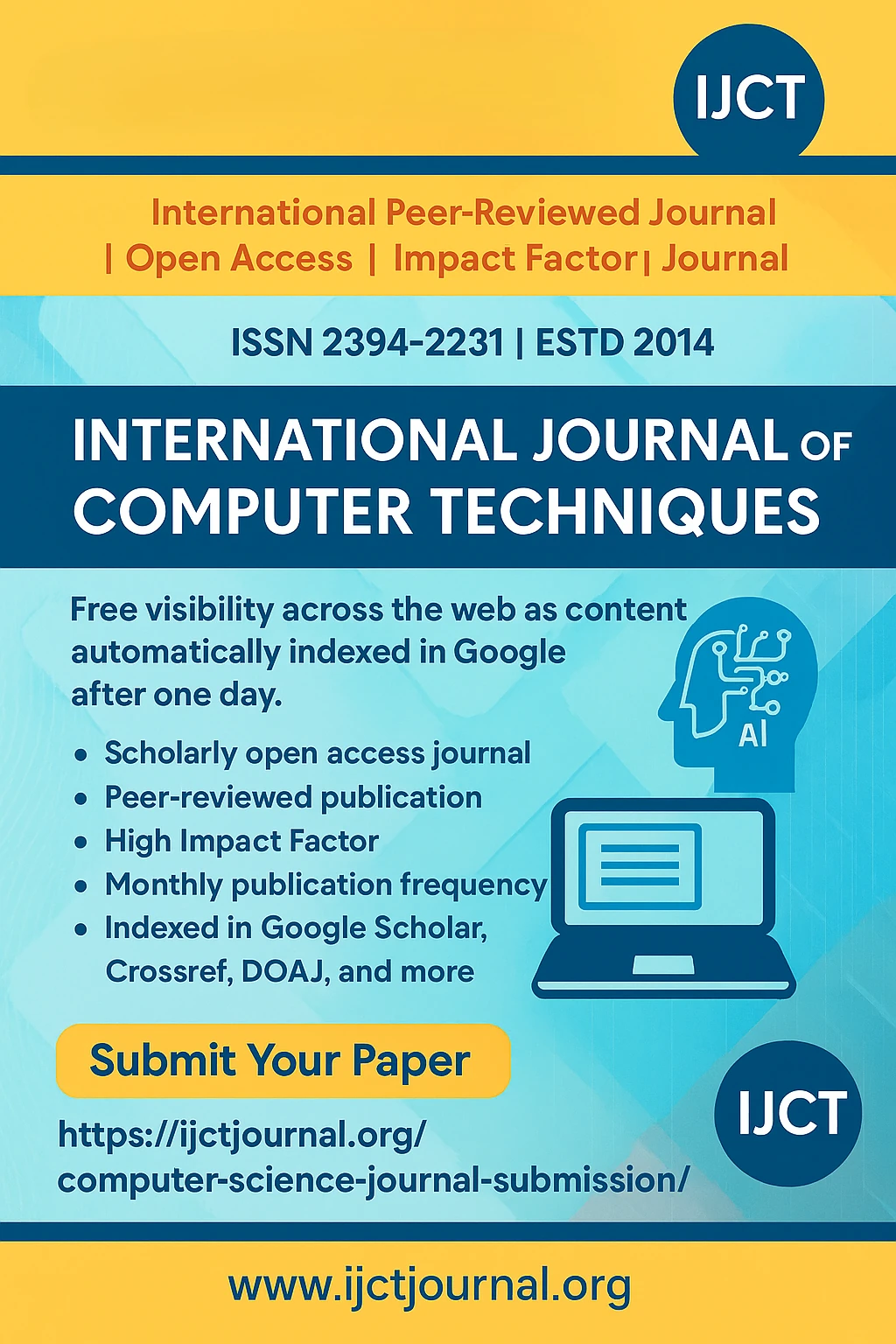
EXPLAINABLE ARTIFICIAL INTELLIGENCE (XAI) FOR MEDICAL DIAGNOSIS: A Comprehensive Review of Interpretability Frameworks, Clinical Integration, and Trust Metrics | IJCT Volume 12 – Issue 6 | IJCT-V12I6P6


International Journal of Computer Techniques
ISSN 2394-2231
Volume 12, Issue 6 | Published: November – December 2025
Author
Abdullah Nuruddin Jalgaonkar
Abstract
Computers that use deep learning are becoming very helpful in medicine. They can study scans, lab results, or heart readings and help doctors find diseases faster and more accurately. But many of these systems work like a mystery box — they give answers without showing how they made them. This lack of clarity makes it hard for doctors and patients to fully trust their results and also creates problems for safety and legal approval . This paper reviews many ways scientists are trying to make these smart systems easier to understand, known as Explainable Artificial Intelligence (XAI). We compare different types of XAI methods, such as models that explain their own decisions and others that explain their decisions afterward (like LIME, SHAP, and Grad-CAM). We also look at how these explanations can fit smoothly into hospital workflows so that doctors can use them easily. Our study shows that for AI to be truly useful in healthcare, it must not only give accurate answers but also explain its thinking in a way people can trust. The framework we propose helps developers create medical AI tools that are both powerful and transparent—turning them from confusing “black boxes” into reliable partners for doctors.
Keywords
Explainable Artificial Intelligence (XAI), Medical Diagnosis, Deep Learning, Model Interpretability, Trust, Clinical Decision Support, LIME, SHAP, Grad-CAM, Human-Computer Interaction.Conclusion
While the results are promising, several limitations remain:
1.Dataset scope: Only two imaging datasets were analyzed; future studies should incorporate larger and more diverse cohorts. 2.Model dependency: Grad-CAM works mainly with CNN models, which means it doesn’t easily adapt to newer model types like transformers or models that handle multiple kinds of data together.
3.Human evaluation scale: The clinician survey sample size was limited; larger,
multi-institutional studies are necessary to validate subjective interpretability scores. 4.Computational cost: SHAP and LIME take a lot of computing power and time to run, which makes them hard to use in real-time situations like hospitals where quick results are needed.
Recognizing these constraints provides a clear roadmap for refining and extending the current work.
References
[1]Lundberg, S. M., & Lee, S.-I. (2017). A unified approach to interpreting model predictions. Advances in Neural Information Processing Systems (NeurIPS), 30, 4765–4774. [2]Samek, W., Montavon, G., Lapuschkin, S., Anders, C. J., & Müller, K.-R. (2021). Explaining deep neural networks and beyond: [3]A review of methods and applications. Proceedings of the IEEE, 109(3), 247–278. [4]Holzinger, A., Biemann, C., Pattichis, C. S., & Kell, D. B. (2017). What do we need to build explainable AI systems for the medical domain? arXiv preprint arXiv:1712.09923. [5]Sheu, R.-K., & Pardeshi, M. S. (2022). A survey on medical explainable AI (XAI): Recent progress, explainability approach, human interaction, and scoring system. Sensors, 22(20), 8068.
[6]Patrício, C., Neves, J. C., & Teixeira, L. F. (2022). Explainable deep learning methods in medical image classification: A survey. arXiv preprint arXiv:2205.04766. [7]da Silva, M. V., et al. (2023). eXplainable artificial intelligence on medical images: A survey. arXiv preprint arXiv:2305.07511. [8]Zhang, H., & Ogasawara, K. (2023). Grad-CAM-Based Explainable Artificial Intelligence Related to Medical Text Processing. Bioengineering, 10(9), 1070. [9]Bhati, D., et al. (2024). A Survey on Explainable Artificial Intelligence (XAI) Techniques in Healthcare. Sensors, 23(2), 634. [10]Kumaran, S. Y., Jeya, J. J., & Rao, K. V. V. (2024). Explainable lung cancer classification with ensemble transfer learning of VGG16, ResNet50, and InceptionV3 using Grad-CAM. BMC Medical Imaging, 24, 176. [11]M., M. M., T. R., M. V. K., et al. (2024). Enhancing brain tumor detection in MRI images through explainable AI using Grad-CAM with ResNet50. BMC Medical Imaging, 24, 107. [12]Holzinger, A., Biemann, C., Pattichis, C. S., & Kell, D. B. (2017). What do we need to build explainable AI systems for the medical domain? arXiv preprint arXiv:1712.09923. [13]Al Amin, K. H., Zein-Sabatto, S., Chimba, D., Ahmed, I., & Islam, T. (2024). An explainable AI framework for Artificial Intelligence of Medical Things (AIoMT). arXiv preprint arXiv:2403.04130. [14]Ghasemi, A., Hashtarkhani, S., Schwartz, D. L., & Shaban-Nejad, A. (2024). Explainable artificial intelligence in breast cancer detection and risk prediction: A systematic scoping review. arXiv preprint arXiv:2407.12058. [15]Suara, S., Jha, A., Sinha, P., & Sekh, A. A. (2024). Is Grad-CAM Explainable in Medical Images? Communications in Computer and Information Science. [16]Livins, T. (2025). Explainable AI in Healthcare: Integrating Grad-CAM and SHAP for Multimodal Diagnostic Systems. Zenodo. [17]Patrício, C., et al. (2022). Explainable Deep Learning Methods in Medical Image Classification: A Survey. arXiv preprint arXiv:2205.04766. [18]Palli, S., Koppireddy, C. S., & Rao, K. V. V. (2023). Explainable AI for Medical Diagnosis: A Review of Current Techniques. Journal of Computer Science Engineering & Software Testing. [19]Zhang, H., & Ogasawara, K. (2023). Grad-CAM-Based Explainable Artificial Intelligence Related to Medical Text Processing. Bioengineering, 10(9), 1070. [20]Samek, W., Montavon, G., Lapuschkin, S., Anders, C. J., & Müller, K.-R. (2021). Explaining Deep Neural Networks and Beyond: A Review of Methods and Applications. Proceedings of the IEEE, 109(3), 247–278. [21]Zhang, H., & Ogasawara, K. (2023). Grad-CAM-Based Explainable Artificial Intelligence Related to Medical Text Processing. Bioengineering, 10(9), 1070.
Journal Covers
IJCT Important Links
© 2025 International Journal of Computer Techniques (IJCT).









